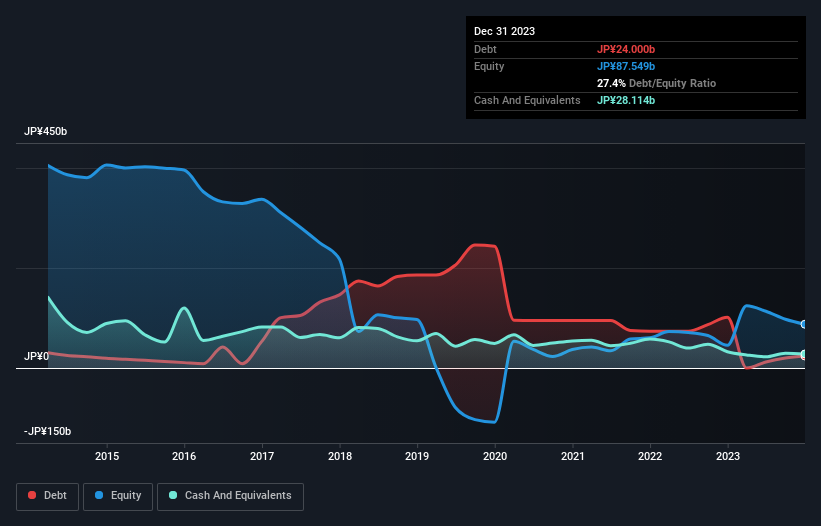- Japan
- /
- Electronic Equipment and Components
- /
- TSE:6740
Is Japan Display (TSE:6740) Weighed On By Its Debt Load?
Some say volatility, rather than debt, is the best way to think about risk as an investor, but Warren Buffett famously said that 'Volatility is far from synonymous with risk.' When we think about how risky a company is, we always like to look at its use of debt, since debt overload can lead to ruin. We can see that Japan Display Inc. (TSE:6740) does use debt in its business. But the more important question is: how much risk is that debt creating?
When Is Debt A Problem?
Debt assists a business until the business has trouble paying it off, either with new capital or with free cash flow. In the worst case scenario, a company can go bankrupt if it cannot pay its creditors. However, a more common (but still painful) scenario is that it has to raise new equity capital at a low price, thus permanently diluting shareholders. By replacing dilution, though, debt can be an extremely good tool for businesses that need capital to invest in growth at high rates of return. The first step when considering a company's debt levels is to consider its cash and debt together.
View our latest analysis for Japan Display
What Is Japan Display's Debt?
The image below, which you can click on for greater detail, shows that Japan Display had debt of JP¥24.0b at the end of December 2023, a reduction from JP¥101.7b over a year. However, it does have JP¥28.1b in cash offsetting this, leading to net cash of JP¥4.11b.

How Strong Is Japan Display's Balance Sheet?
According to the last reported balance sheet, Japan Display had liabilities of JP¥115.1b due within 12 months, and liabilities of JP¥14.0b due beyond 12 months. Offsetting this, it had JP¥28.1b in cash and JP¥42.7b in receivables that were due within 12 months. So its liabilities outweigh the sum of its cash and (near-term) receivables by JP¥58.2b.
Japan Display has a market capitalization of JP¥117.6b, so it could very likely raise cash to ameliorate its balance sheet, if the need arose. However, it is still worthwhile taking a close look at its ability to pay off debt. While it does have liabilities worth noting, Japan Display also has more cash than debt, so we're pretty confident it can manage its debt safely. The balance sheet is clearly the area to focus on when you are analysing debt. But it is Japan Display's earnings that will influence how the balance sheet holds up in the future. So when considering debt, it's definitely worth looking at the earnings trend. Click here for an interactive snapshot.
Over 12 months, Japan Display made a loss at the EBIT level, and saw its revenue drop to JP¥243b, which is a fall of 17%. That's not what we would hope to see.
So How Risky Is Japan Display?
We have no doubt that loss making companies are, in general, riskier than profitable ones. And we do note that Japan Display had an earnings before interest and tax (EBIT) loss, over the last year. Indeed, in that time it burnt through JP¥51b of cash and made a loss of JP¥46b. Given it only has net cash of JP¥4.11b, the company may need to raise more capital if it doesn't reach break-even soon. Summing up, we're a little skeptical of this one, as it seems fairly risky in the absence of free cashflow. When analysing debt levels, the balance sheet is the obvious place to start. However, not all investment risk resides within the balance sheet - far from it. These risks can be hard to spot. Every company has them, and we've spotted 2 warning signs for Japan Display you should know about.
When all is said and done, sometimes its easier to focus on companies that don't even need debt. Readers can access a list of growth stocks with zero net debt 100% free, right now.
New: Manage All Your Stock Portfolios in One Place
We've created the ultimate portfolio companion for stock investors, and it's free.
• Connect an unlimited number of Portfolios and see your total in one currency
• Be alerted to new Warning Signs or Risks via email or mobile
• Track the Fair Value of your stocks
Have feedback on this article? Concerned about the content? Get in touch with us directly. Alternatively, email editorial-team (at) simplywallst.com.
This article by Simply Wall St is general in nature. We provide commentary based on historical data and analyst forecasts only using an unbiased methodology and our articles are not intended to be financial advice. It does not constitute a recommendation to buy or sell any stock, and does not take account of your objectives, or your financial situation. We aim to bring you long-term focused analysis driven by fundamental data. Note that our analysis may not factor in the latest price-sensitive company announcements or qualitative material. Simply Wall St has no position in any stocks mentioned.
About TSE:6740
Japan Display
Develops, designs, manufactures, and sells displays and related products in Japan and internationally.
Slight risk and overvalued.
Similar Companies
Market Insights
Community Narratives


